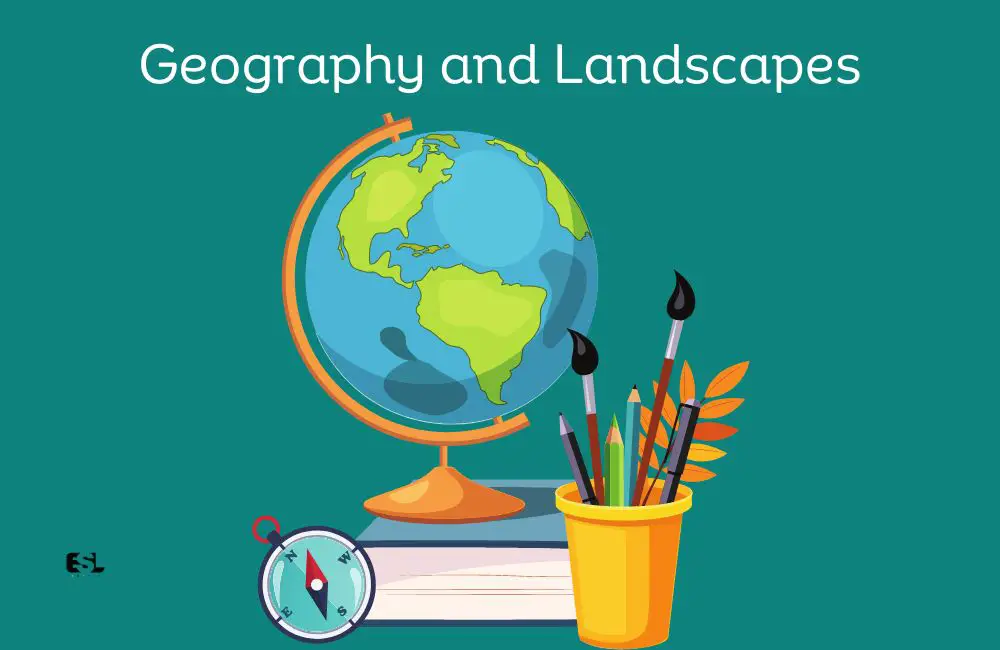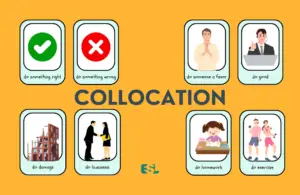Vocabulary is the cornerstone of understanding and describing the world around us. It aids in painting vivid pictures in our minds and assists us in conceptualizing the diversity of our planet. As we explore geographical and landscape-related terms, we dive deeper into the language that helps us depict Earth’s captivating features.
Whether you’re a seasoned traveler, a student of geography, or just someone with a profound love for our planet, understanding and using this vocabulary will enhance your knowledge and appreciation of the world’s landscapes. This article presents an in-depth categorization of geographical and landscape terms with their usage and illustrative examples.
Table of Contents
- 1. Landforms and Terrain
- 2. Bodies of Water
- 3. Weather and Climate
- 4. Forest and Vegetation
- 5. Geological Processes
- 6. Human Geography
- Sample Conversation: Using Vocabulary Related to Geography and Landscapes
- In Conclusion
- FAQ: Vocabulary Related to Geography and Landscapes
1. Landforms and Terrain
To navigate Earth’s physical geography, it is crucial to understand the distinct features that give character to our world’s diverse terrain. This section covers the language used to describe mountains, valleys, plains, and other natural landforms.
| Word | Meaning | Example Sentence |
|---|---|---|
| Mountain | A large, natural elevation of the earth’s surface | The Mount Everest is the highest mountain in the world. |
| Valley | A low area of land between hills or mountains | The lush green valley was a beautiful sight to behold. |
| Plains | Large areas of flat land | The Great Plains of North America stretch over several states. |
| Plateau | An area of relatively high ground | The Colorado Plateau in the United States is famous for its stunning rock formations. |
| Canyon | A deep gorge, usually with a river flowing through it | The Grand Canyon is one of the most famous canyons in the world. |
| Hill | A naturally raised area of land, smaller than a mountain | The town is located on a hill overlooking the sea. |
| Dune | A mound or ridge of sand formed by the wind | The Sahara Desert is known for its large sand dunes. |
| Glacier | A slowly moving mass of ice | The melting of glaciers is a significant concern due to global warming. |
| Volcano | A mountain with a crater through which lava has erupted | The eruption of the volcano caused a lot of damage to the nearby villages. |
| Cave | A natural hole or hollow place in the ground | The cave was full of beautiful stalactites and stalagmites. |
| Cliff | A high, steep rock face | The cliff overlooks the vast, blue ocean. |
If you are searching for an effective English language vocabulary builder, try Word Power Made Easy: The Complete Handbook for Building a Superior Vocabulary (Amazon Link). This time-tested classic has helped millions achieve mastery of English and improve their communication skills in business, the classroom, and in life.
2. Bodies of Water
Water bodies make up a significant portion of Earth’s surface. We’ll explore vocabulary terms used to describe different types of water bodies, from expansive oceans and seas to small streams and ponds.
| Word | Meaning | Example Sentence |
|---|---|---|
| Ocean | The vast body of salt water that covers almost three fourths of the earth’s surface | The Pacific Ocean is the largest ocean on Earth. |
| Sea | A large body of saltwater smaller than an ocean, partly or completely surrounded by land | The Red Sea is known for its vibrant coral reefs. |
| River | A large, flowing body of water that usually empties into a sea or ocean | The Amazon River in South America is the world’s largest by volume. |
| Lake | A large body of water surrounded by land | Lake Superior is the largest of the Great Lakes in North America. |
| Stream | A small, narrow river | The stream flowed gently through the forest. |
| Pond | A small body of still water | The pond was teeming with ducks and swans. |
| Creek | A small, narrow, shallow stream | The children loved to play near the creek. |
| Lagoon | A stretch of salt water separated from the sea by a low sandbank or coral reef | The lagoon was teeming with a variety of marine life. |
| Bay | A broad inlet of the sea where the land curves inward | The city is located on the bay, providing stunning ocean views. |
| Gulf | A deep inlet of the sea almost surrounded by land, with a narrow mouth | The Gulf of Mexico is known for its warm waters. |
3. Weather and Climate
Understanding the terminology of weather and climate is key to deciphering the conditions that mold our planet’s landscapes. This section introduces words related to various weather conditions and climate zones.
| Word | Meaning | Example Sentence |
|---|---|---|
| Rain | Water falling in drops from the sky | The rain made the streets glisten. |
| Snow | Atmospheric water vapor frozen into ice crystals and falling in light white flakes or lying on the ground as a white layer | Snow covers the mountains every winter. |
| Sun | The star around which the earth orbits | The sun was shining brightly in the blue sky. |
| Cloud | A visible mass of condensed water vapor floating in the atmosphere | The clouds were fluffy like cotton candy. |
| Thunderstorm | A storm with thunder and lightning and usually heavy rain | The thunderstorm last night was quite severe. |
| Wind | The perceptible natural movement of the air | The wind blew her hair across her face. |
| Fog | A thick cloud of tiny water droplets suspended in the atmosphere | The fog was so thick that we couldn’t see anything. |
| Heatwave | A prolonged period of abnormally hot weather | The city has been experiencing a heatwave for the past week. |
| Drought | A prolonged period of below-average precipitation | The region has been hit by a severe drought. |
| Humidity | The amount of water vapor in the air | The humidity today is making the heat feel even worse. |
| Blizzard | A severe snowstorm with high winds | The blizzard made the roads impassable. |
4. Forest and Vegetation
Forests and vegetation are integral parts of landscapes, offering habitats to numerous species and playing a crucial role in Earth’s climate. In this section, we will learn terms related to various types of forests and vegetation.
| Word | Meaning | Example Sentence |
|---|---|---|
| Forest | A large area covered chiefly with trees and undergrowth | The Amazon forest is the largest rainforest on Earth. |
| Jungle | An area of land overgrown with dense forest and tangled vegetation | The explorers made their way through the thick jungle. |
| Grassland | Land with grass growing on it, especially used for grazing by farm animals | The African savanna is a type of tropical grassland with scattered trees. |
| Marsh | A wetland that is dominated by herbaceous rather than woody plant species | Many birds nest in the marsh. |
| Swamp | A wetland that is forested | The swamp was teeming with a variety of wildlife. |
| Desert | A barren area of landscape where little precipitation occurs, consequently living conditions are hostile for plant and animal life | The Sahara is the largest hot desert in the world. |
| Rainforest | A luxuriant, dense forest rich in biodiversity, found typically in tropical areas with consistently heavy rainfall | Rainforests are critical for maintaining Earth’s biodiversity. |
| Bush | A shrub or clump of shrubs with stems of moderate length | The Australian outback is often referred to as the bush. |
| Meadow | A field habitat vegetated by grass and other non-woody plants | The meadow was filled with blooming wildflowers. |
| Tundra | A type of biome where the tree growth is hindered by low temperatures and short growing seasons | The Arctic tundra is known for its cold, desert-like conditions. |
| Savannah | A mixed woodland-grassland ecosystem characterized by the trees being sufficiently widely spaced so that the canopy does not close | The African savannah is home to a variety of wildlife, including lions and elephants. |
5. Geological Processes
Geological processes have been shaping Earth’s landscapes for billions of years. Here, we look at terms that describe these potent and transformative processes.
| Word | Meaning | Example Sentence |
|---|---|---|
| Erosion | The process of eroding or being eroded by wind, water, or other natural agents | Coastal erosion is a significant problem in many seaside communities. |
| Sedimentation | The process of settling or being deposited as a sediment | Rivers play a significant role in the process of sedimentation. |
| Volcanism | The phenomenon of eruption of molten rock onto the surface of the Earth | Volcanism is responsible for creating some of the most fertile soils on the planet. |
| Earthquake | A sudden and violent shaking of the ground | The earthquake caused significant damage to the city. |
| Weathering | The breaking down of rocks, soil, and minerals through direct contact with the Earth’s atmosphere | Weathering of rocks over time can lead to the formation of sand. |
| Tsunami | A long, high sea wave caused by an earthquake or other disturbance | The tsunami resulted in widespread devastation along the coast. |
| Flood | An overflow of water that submerges land | The river flooded due to the heavy rain. |
| Landslide | The sliding down of a mass of earth or rock from a mountain or cliff | The landslide blocked the road completely. |
| Drought | A prolonged period of below-average precipitation | The region has been hit by a severe drought. |
| Glacier Movement | The motion of glaciers, which can be likened to rivers of ice | Glacier movement is a slow but constant process. |
| Lava Flow | The movement of molten rock expelled by a volcano during an eruption | The lava flow destroyed everything in its path. |
6. Human Geography
Human geography considers the role of humans in shaping landscapes and their environments. The terms in this section pertain to human-built or influenced aspects of landscapes.
| Word | Meaning | Example Sentence |
|---|---|---|
| Urban | In, relating to, or characteristic of a city or town | The urban landscape is dominated by buildings and roads. |
| Rural | In, relating to, or characteristic of the countryside rather than the town | Rural landscapes are often defined by agricultural fields and small towns. |
| Infrastructure | The basic physical and organizational structures and facilities needed for the operation of a society | The city has been investing heavily in infrastructure. |
| Industrial | Relating to or characterized by industry | The city’s skyline is dominated by industrial factories. |
| Residential | Designed for people to live in | The residential area is quiet and peaceful. |
| Commercial | Making or intended to make a profit | The commercial district is bustling with activity. |
| Agricultural | Relating to the science or practice of farming | The agricultural landscape is characterized by large, open fields. |
| Metropolitan | Relating to a densely populated urban area | The metropolitan area is known for its cultural diversity. |
| Suburban | Relating to a suburb, the area on the edge of a large town or city | The suburban neighborhood is known for its well-kept homes and lawns. |
| Downtown | The commercial center of a town or city | The downtown area is bustling with activity. |
| Slum | A squalid and overcrowded urban street or district inhabited by very poor people | The government is working on improving conditions in the city’s slums. |
To improve your vocabulary in just 30 days, I recommend to my students an informative, fun, and accessible guide to utilizing powerful language. Millions of individuals have enhanced their academics, job skills, and confidence by dedicating just fifteen minutes daily to the exercises and tests of 30 Days to a More Powerful Vocabulary (Amazon Link), a top-selling. It offers step-by-step methods to bolster language prowess, discover compelling words, and daily vocabulary enhancement with pronunciation guidance.
Sample Conversation: Using Vocabulary Related to Geography and Landscapes
Situation: At a local library, two students, Sarah and Leo, are discussing their geography assignment about the world’s most mesmerizing landscapes.
Sarah: Leo, I’ve always been captivated by the diverse topography of our planet. From the vast plains of Africa to the towering mountain ranges in Asia, there’s so much to explore!
Leo: You’re absolutely right, Sarah. And don’t forget the tundras of the Arctic or the dense rainforests of the Amazon. Each landscape offers a unique ecosystem with its own set of flora and fauna.
Sarah: True. I’m particularly intrigued by archipelagos. The way islands are grouped together, surrounded by the vast ocean, is just fascinating.
Leo: Yes, and then there are the canyons and valleys, carved by rivers over millennia, showcasing the power of erosion and time.
Sarah: Speaking of water bodies, lakes nestled between mountains or within craters are such serene sights. Like Lake Baikal in Russia, which is also the world’s deepest and oldest freshwater lake.
Leo: Geography is truly amazing. It offers insights not only into the physical features of the Earth but also into the cultural and historical contexts of various regions. Makes you appreciate the beauty and diversity of our world, doesn’t it?
In Conclusion
Geography and landscapes are more than just places on a map; they are an intricate weave of physical attributes, climate conditions, and human influences. Understanding and using the vocabulary related to these fields not only broadens our linguistic capacities but also enhances the comprehension of our world.
By mastering these terms, we can more accurately and effectively communicate about our planet’s beautiful diversity and complexities. This knowledge enriches our respect for the environment and equips us to take more meaningful actions to protect and preserve it.
FAQ: Vocabulary Related to Geography and Landscapes
1. What does topography refer to?
Topography describes the physical features of an area, such as its mountains, valleys, and rivers. It gives an overview of the landscape and its elevations.
2. How are plains different from plateaus?
Plains are flat, sweeping lands that don’t have much change in elevation. In contrast, plateaus are elevated flat areas, often surrounded by steep sides.
3. What is a tundra?
A tundra is a vast, treeless region, usually found in cold climates, characterized by low temperatures and short vegetation.
4. Why are rainforests important to the ecosystem?
Rainforests are biodiversity hotspots, home to a vast number of plant and animal species. They play a crucial role in regulating the Earth’s climate and producing oxygen.
5. Can you explain what an archipelago is?
An archipelago is a group or chain of islands clustered together in a sea or ocean.
6. How are canyons formed?
Canyons are deep gorges created over time by the erosive activity of rivers cutting through the Earth’s crust, often showcasing layered rock formations.
7. What defines a valley?
A valley is a low area of land situated between hills or mountains, often with a river or stream running through it.
8. How do lakes differ from lagoons?
While both are water bodies, lakes are large inland bodies of standing water. In contrast, lagoons are shallow bodies of water separated from a larger body of water (like a sea) by a barrier.
9. What is a crater in geographical terms?
A crater is a bowl-shaped depression or cavity on the Earth’s surface, often resulting from volcanic activity or the impact of a meteorite.
10. Why is studying geography important?
Studying geography provides insights into the physical world, human societies, and the interaction between the two. It fosters an understanding of global issues, cultural differences, and the interconnectedness of our world.






